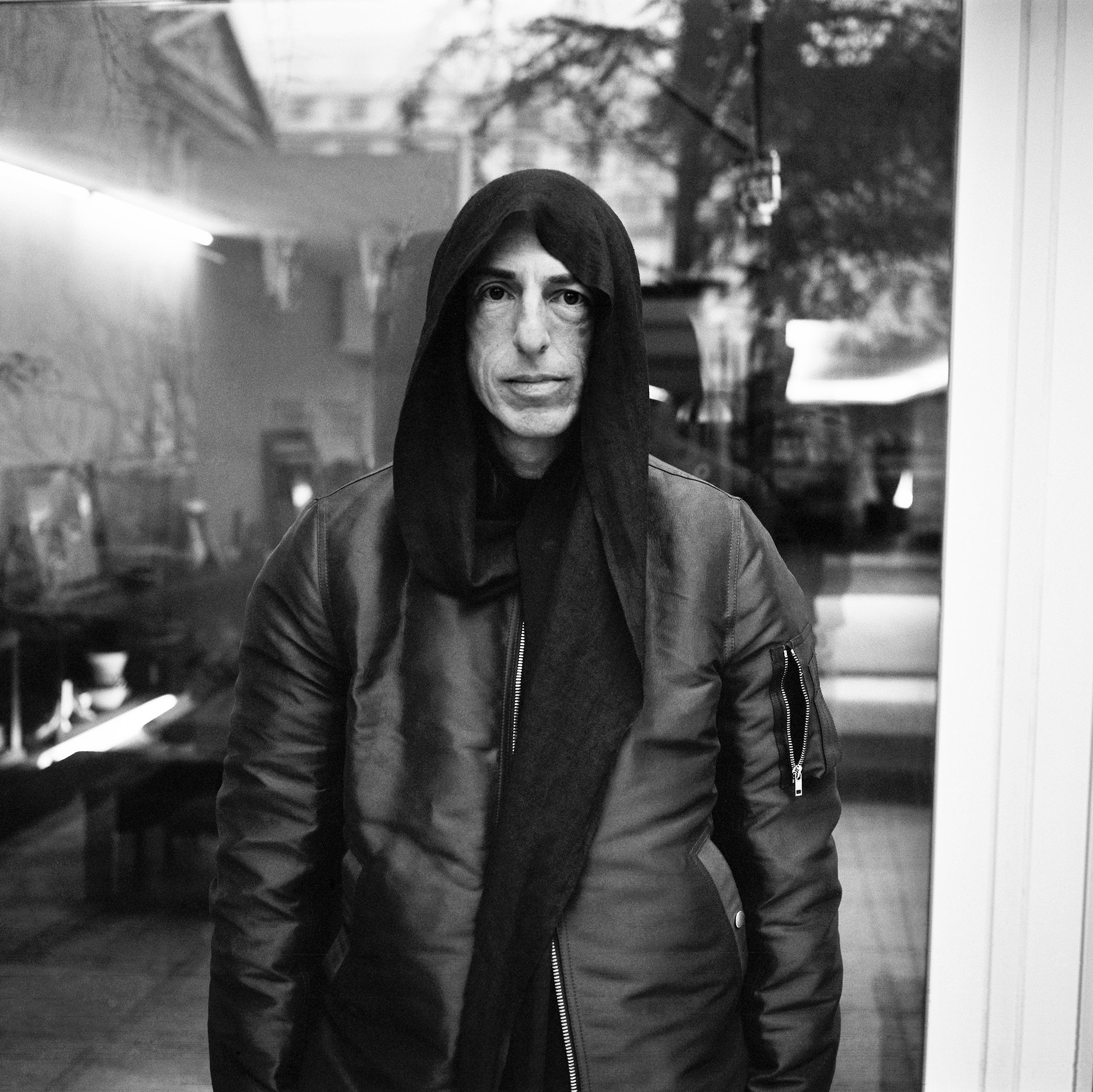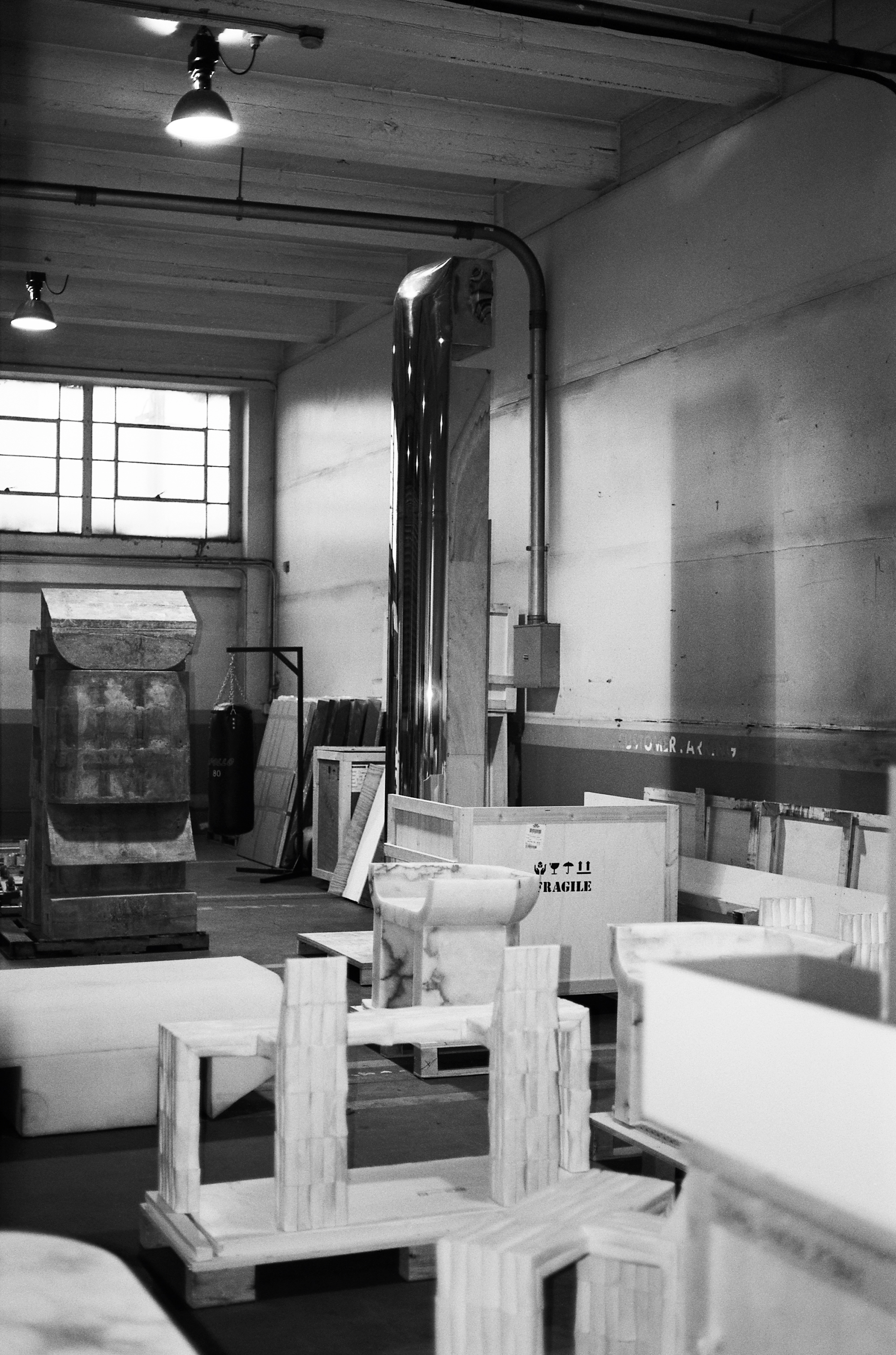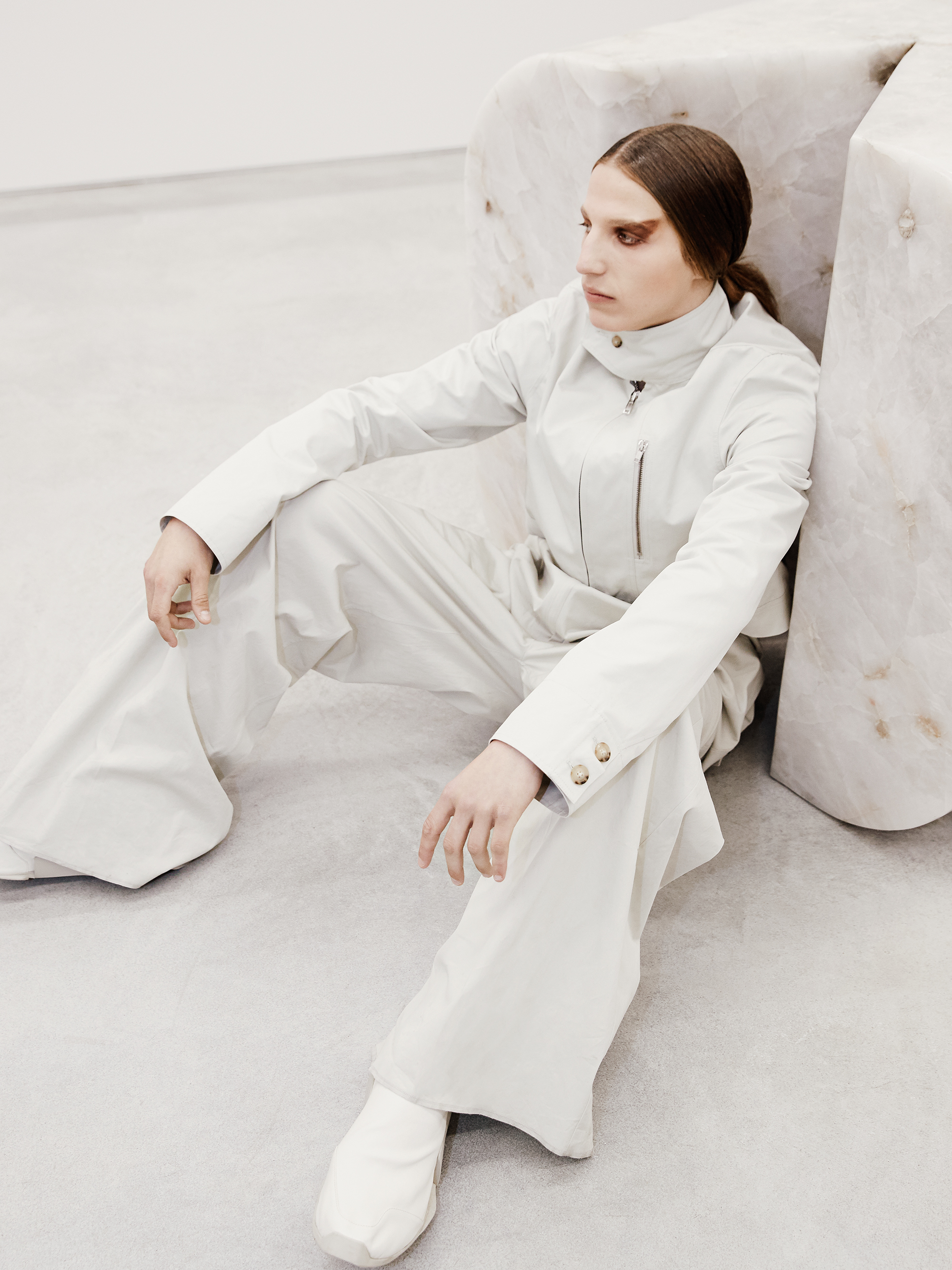Purple Magazine
— S/S 2017 issue 27
Rick Owens
dark magic
interview and portraits by OLIVIER ZAHM
photography by ALEX ANTITICH
Who could have imagined, when the young Rick Owens created his first collection in 1994 in Los Angeles that he would become, more than 20 years later, one of the most acclaimed, persistent, rigorous, and radical fashion designers, incarnating brutal chic, fearless sexuality, and gender fluidity, as well as extreme innovation in forms, contrasts, and fabrics?
Living in Paris for the past 13 years, Rick Owens continues to surprise fashion fans. Step-by-step, from show to show, he’s expanded his supporters from rebellious anti-fashion kids to elegant European women looking for allure and distinction. He never repeats himself and has never compromised along his dark, mysterious path. Reticent but openminded and kind, he avoids the media. He is especially supportive of young artists and designers, such as Gareth Pugh.
His longevity, creativity, clairvoyance, and honesty are a radical exception in fashion today… And now, with his wife Michèle, he’s added his imprint to the design world with a line of furniture that challenges functionality with a totemic aura and striking sculptural impact.
OLIVIER ZAHM — So, Rick, you were saying…
RICK OWENS — I’ve been talking a lot about ecology in the past couple of seasons, not because I know what I’m talking about ecologically, although I think it’s a good idea. What I like are the intentions, but the problem is that the fundamental human urge is to procreate.
OLIVIER ZAHM — Which goes with pollution and consumption?
RICK OWENS — Well, yes, and the urge to live forever: procreation and to live forever. We all have these urges. People have more babies. They live longer. The world is becoming more crowded and using up its resources. So we have to genetically modify resources to extend them. Maybe all this reaches a kind of climax, and something else happens. My train of thought was that maybe [there’s] a transition, with the idea of accepting it gracefully, and figuring out how to make the transition as elegant and graceful as possible, instead of feeling dread, panic, and hysteria…
OLIVIER ZAHM — And not having too radical or violent a transition?
RICK OWENS — Yeah. But that’s a very fatalistic attitude, and that’s not that healthy, either. I don’t mean to make any kind of strident opinion because I’m not good at strident opinions. I’m the least opinionated. But I do like to see every side of an issue.
OLIVIER ZAHM — We’re definitely facing a big change globally and politically, but also in fashion. Fashion’s changed so much since you started.
RICK OWENS — Can you believe it? Isn’t it crazy?
OLIVIER ZAHM — Yes. There are so many brands, even fake brands on the Internet.
RICK OWENS — I don’t even see the full spectrum the way you do because you’re out there searching and exploring all the time. What’s it like? I should interview you. How do you maintain interest?
OLIVIER ZAHM — It’s a bit destabilizing. But there’s also a paradox. With more brands on the market, more designers, more boutiques, and more e-commerce emerging and coexisting today, you need real creativity and a point of view. But, you know, I also feel that creativity is back — and that you’re one of the rare designers who maintain creative ambition.
RICK OWENS — I don’t know if it’s a bad thing that there are so many brands. I mean, there I go again. I’m always saying, “Everything’s okay.” I have a thing about not being overly critical. I am aesthetically critical because that’s my job. I look at everything I make and eliminate what isn’t as good as it possibly can be. So I have to be critical. But in life, I’m very conscious of not being a critical voice.
OLIVIER ZAHM — Of negativity?
RICK OWENS — Yeah, because it’s just too easy to be negative: everyone does that. So why should I join them? That’s why I feel like I end up being ambiguous. But aesthetically, I have a very definite point of view.
OLIVIER ZAHM — Yes, and a very precise one.
RICK OWENS — I hope so. But with so many creative voices in the world, maybe it’s just another option. Anyway, the best always rises to the surface.
OLIVIER ZAHM — But it’s a dissolution of creativity, with all these new brands and new fake brands.
RICK OWENS — I have gay friends in their 50s and 60s who’ve never had a long-term relationship because they were too handsome. But they would like to be in a relationship. It’s just that they had too many options. And it’s…
OLIVIER ZAHM — A metaphor for what’s going on today?
RICK OWENS — I think so. To never be able to focus on one person because there are always too many choices is hard. That’s kind of what the fashion world is like now. Sometimes when I look at fashion, or at the magazines, everything looks like a teenage girl’s closet, with lots of cute, happy, funny, cheerful things, without a specific point of view. But that’s not the entire world. There is a faction that knows precisely what they want, that wants to edit and to eliminate.
OLIVIER ZAHM — To eliminate the superficiality?
RICK OWENS — To eliminate the need to change looks every day or every week.
OLIVIER ZAHM — By looking for a certain or a more stable kind of elegance?
RICK OWENS — Or not to need so much stimulation. Stimulation is great. There was a time when I loved being over-stimulated. I have very fond memories of that. But it’s not the same. And I’m not the only person like that. So, luckily for me, there’s a faction that will accept the things I propose. I have a very small corner of the fashion world. It’s a very quiet little niche, which is fantastic.
OLIVIER ZAHM — But it’s growing — your clientele is growing.
RICK OWENS — But I’m never going to be able to satisfy everybody. I would never be able to run a big house where you have to satisfy a lot of people. I don’t think that can happen for me. I think I’ve gotten this far because my aesthetic is so narrow. I would never be able to satisfy a greater need.
OLIVIER ZAHM — I think your audience is growing.
RICK OWENS — I’m not in any way bragging, but things happen in cycles. Sometimes what you’re doing resonates with the world and is relevant, and sometimes not. You can see how some designers are relevant at a moment, and then something else happens.
OLIVIER ZAHM — Something happens. It’s the same for magazines.
RICK OWENS — That’s what I’m saying. Like you and me. What are we going to do?
OLIVIER ZAHM — Once we reach a certain point, there’s no turning back.
RICK OWENS — Well, if we don’t recognize it, that could happen.
OLIVIER ZAHM — You have a narrow but very precise point of view, and you also change. Each collection is different from the one before, and you’re able to constantly find new inspiration. Each time I see one of your shows, I’m surprised.
RICK OWENS — You know what? I love it when somebody can do a very small gesture and change things. That’s something I admire. I’m very conscious of that. I love the idea of something small making a difference. So if I can kind of do that…
OLIVIER ZAHM — And constantly reinvent yourself?
RICK OWENS — Without having to exert myself completely, without having to be a total whore, with subtle little tweaks. Yeah, that’s a great thing. That’s kind of what I aim for.
OLIVIER ZAHM — How do you work? Do you challenge yourself to constantly evolve?
RICK OWENS — I do. It’s a lot of work. And I really do challenge myself.
OLIVIER ZAHM — But how do you start? With a fabric? An idea? Music?
RICK OWENS — Well, you know, I never start because I never stop. Because you’re working on spring at the same time that you’re showing fall fashion. It’s always a series. I’m consuming ideas and aesthetics, and all the time looking around for things that look right. I’m looking at colors. I’m looking at lines in the street. I’m on the metro, and I’m looking at people’s shoes in the metro: how would I do that? How would I change it? It’s always a rolling process that never really starts at any one place. I just collect a bank of ideas in my head, or images on my computer, and then eventually it all gets put together in a collection. I go through all of the stimulations and make a composition of things I’ve seen.
OLIVIER ZAHM — So you’re always in the middle of work.
RICK OWENS — Which I love. I like going fast. I like being stimulated and having a sense of purpose every day. I don’t want to go any slower. It’s great. And it would be different if I worked for a company. It would be too different.
OLIVIER ZAHM — But you did the fur company.
RICK OWENS — Yeah. It was a great experience — I mean, Revillon. But I only did it because they didn’t have any money, and I had more money. I did it because of the craftsmanship. Because it was purely fur. It was the very top. It was just to get them started. And then they didn’t have enough muscle to really move it forward. But I had a wonderful time while I was there.
OLIVIER ZAHM — I really enjoyed your Revillon collection at the time.
RICK OWENS — I did, too, and it was a fun thing to do. But the thing I really hadn’t anticipated was that it made people in Paris accept me in a different way — than if I’d been simply an American coming to present my collections. They were impressed. But I didn’t do it deliberately. It wasn’t calculated. It just happened. And I still do furs. Ever since then, we’ve always done furs, and we have them produced in Paris, and it’s a nice story.
OLIVIER ZAHM — Let’s speak about sexuality today because fashion changed, but sexuality has changed, too.
RICK OWENS — You know what? I’m reading Shock and Awe, by Simon Reynolds. It’s about glam rock, glitter rock. I’d called the new collection “Glitter,” and then I got this book, which is all about glitter rock and everything glam.
OLIVIER ZAHM — Is this an inspiration for your the Fall/Winter 2017 collection?
RICK OWENS — Yes. That’s the collection I’m working on right now; I’m calling it “Glitter,” even though I’m not going to do any sequins or beads. It’s more about the energy, the idea of flamboyance and transgression — and there was a joyous energy about sexual liberation at the time. There was also a sense of humor, and the idea of embracing the ridiculous. Now, I hate being one of those old guys who talks about how it was better before. I mean, I didn’t live through glam rock, either. That was right before my time. But contemporary Internet culture is very much about collage and pastiche.
OLIVIER ZAHM — And reproductions and copies?
RICK OWENS — Everything is copying anyway. In any creative gesture, you are working with something that came before. But it’s so literal now. I’m not criticizing it. I’m thinking, “What does that mean?”
OLIVIER ZAHM — Because there are literal copies, which maybe push something from inside the copy? A different look at the past?
RICK OWENS — Everyone copies. Some are smart, and some aren’t.
OLIVIER ZAHM — But to go back to sexuality and glamour, we are in a new sexual revolution today through the Internet.
RICK OWENS — Are we? Tell me.
OLIVIER ZAHM — I’ll tell you a few signs. People are constantly taking selfies and promoting themselves on the Internet, and so the possibilities of contact are extended, with connections all over the planet. This liberates people from the boyfriend or girlfriend and the little circle around them. It creates a new kind of openness and a new possibility of freedom.
RICK OWENS — But doesn’t it make it harder to connect because of too many choices?
OLIVIER ZAHM — Yes. Like what you said before about handsome people unable to decide on a single lover.
RICK OWENS — Add to that the fact that people in this generation feel entitled — to be better and to have more.
OLIVIER ZAHM — There’s also what’s called “gender fluidity,” which opens up the gender definition like never before.
RICK OWENS — No. They did it harder, stronger, bigger, and louder in the ’70s, which was way more adventurous. Kids can do anything, and there’s no big scandal. Then, it was hard to wear lipstick. That alone was transgressive and super hard core. Maybe it was about the drugs back then. There was more acid.
OLIVIER ZAHM — That’s true.
RICK OWENS — With hallucinogenic drugs, people were expanding their minds and seeing things in the extreme. Options seemed endless; possibilities were exciting. Now, what are they doing? They’re doing ice, meth, and ecstasy. They’re not explorative or adventurous drugs. It’s a different thing.
OLIVIER ZAHM — Well, it’s more narcissistic, more about yourself.
RICK OWENS — Maybe kids need acid.
OLIVIER ZAHM — But it’s funny that you go back to glam because you’re famous for gray, black, and earthy colors, like brown.
RICK OWENS — Yeah.
OLIVIER ZAHM — Are you looking at colors?
RICK OWENS — Well, I am doing colors more than I used to, and the reason is that I have a bit more control with dye houses and fabric people than I did 10 years ago. Now I’m able to get the weird, saturated colors with neutral tones.
OLIVIER ZAHM — Which is more like you.
RICK OWENS — So I can do colors better than I did before.
OLIVIER ZAHM — In the Spring/Summer 2016 collection there was a beautiful purple dress.
RICK OWENS — Yeah, technically: a purple that has green in it, and an orange that has blue in it. I’m now able to get colors that I want just a little bit better. I mean, I love flamboyance and transgression, but my whole thing, when I started out, was to exaggerate shapes in a soft gray, which made them not so much about special occasion dressing. I took more radical shapes and brought them into the daytime, so that people could wear them every day. I always wanted to bring flamboyance and exaggeration into normal life. I never wanted there to be a disconnection between exaggeration and what you could really do. Do you remember The Rocky Horror Picture Show? There was a song: “Don’t Dream It, Be It.” That inspired me. And that was about glitter rock. But it wouldn’t work now because people can get away with anything. I mean, young kids wear eyeliner now. Who cares? It’s been done.
OLIVIER ZAHM — That’s true. But this banality today is also the starting point for a new possibility because, as you say, it’s not a stage. This kind of transgression or attitude can be introduced into everyday life because, in a way, there’s no transgression anymore.
RICK OWENS — But people won’t do it. There was an appreciation of the ridiculous. People won’t allow themselves to be ridiculous anymore because of the criticism. Everybody is criticized on the Internet. Whatever you wear, people are going to criticize you. So now, because there’s too much criticism, it’s all about restraint; it’s all about wearing something uncriticizable. Which is an interesting thing. It creates different rules, which are fun to play with, too. So the clothes that look interesting now are things that are very conservative, with a little bit of weirdness. I like the weirdness. Flamboyant Claude Montana clothes simply would not make sense right now. They would look like you are trying too hard. There has to be indifference right now in appearance. You have to appear indifferent and effortless. The rules are different. When you see how the rules change, you have to adapt.
OLIVIER ZAHM — But my point about sexuality is about a new generation of people who are more open sexually, or to their sexual identity, which is more complex and maybe less conformist. And fashion is a way to express that sexual identity. There are a number of young designers who are role models. And I think you’re someone who opened up this possibility in fashion.
RICK OWENS — That’s great.
OLIVIER ZAHM — Yes, that’s great because generally, with fashion and with fashion design, there is usually a clearly established division between male and female. And you blur this division. You start from a certain elegance and a certain attitude, which is very inspiring for this new generation of designers — like with Hood By Air, for example. There are others.
RICK OWENS — Yeah, if I’m able to corrupt young straight boys, I love that. Oh, god. I’m going to be jailed for saying that.
OLIVIER ZAHM — Is your work about transgression and love?
RICK OWENS — Yes, it’s still about love. What we’re saying is that kids need to get their energy up and take some fucking acid.
OLIVIER ZAHM — Nothing is real without love. Otherwise, it’s empty.
RICK OWENS — It’s a cheerful, affectionate transgression. It’s certainly not anger. I’m never angry.
OLIVIER ZAHM — We feel that in your collection and in your last show — the love you expressed.
RICK OWENS — Wasn’t that gorgeous?
OLIVIER ZAHM — It was fantastic.
RICK OWENS — “Black Is the Color of My True Love’s Hair” — that song, the first song, was amazing. So beautiful.
OLIVIER ZAHM — So just one word about your furniture. Your furniture is now established in the design world. But now you’re a designer of clothes and furniture. How do you differentiate them? Or are they equal?
RICK OWENS — Equal? Oh god, no. The clothes are way, way bigger than the furniture. The furniture is a wonderful thing to do, in galleries and stuff. In fact, I have a show opening at MOCA [Museum of Contemporary Art, Los Angeles]. Michèle is in Los Angeles right now installing it. And I have a book coming out with Rizzoli for the furniture at the same time. The book will be available at the opening. But the furniture is really Michèle’s creation. I mean, I started it, but then Michèle put the energy into it. Because making furniture requires a lot of love and attention.
OLIVIER ZAHM — It’s a very complex process.
RICK OWENS — It’s also not something that we really needed to do. It wasn’t a business idea. It was an aesthetic indulgence and fun to do together. Then it found an audience, which was nice.
OLIVIER ZAHM — And reconnection in the design world. You and Michèle are now also seen as furniture designers.
RICK OWENS — But the reason is because it’s a personal and very sincere expression of the way we live and of things we want. Which is ironic, I guess, because if you look around this house, there’s almost nothing from the furniture collection here — because all the pieces are in shows. Everybody else gets a delivery before I do. So this personal expression benefits everyone but us.
OLIVIER ZAHM — Yes, aren’t they more Brutalist than comfortable?
RICK OWENS — You’d be surprised. A lot have mattresses fitted into them. So almost everything ends up being a daybed, or a big bench. You put a mattress on it, and it’s a daybed. And then there are the beds — and the chairs! Oh, you have to see the bone chairs.
OLIVIER ZAHM — So fashion and furniture design are two distinct activities. Are they totally different in your mind, or are they part of a related inspiration?
RICK OWENS — It really is a very selfish exercise of what I want, what I want to say, and what I want to produce. But it’s almost never: “What do people want?” Or even, “What do people need?” That wouldn’t work. I call it a conversation. What’s great about making things is being listened to. Everybody wants to be listened to. You want your children to listen to you. You want your lover to listen to you. You want somebody to listen to you.
OLIVIER ZAHM — True.
RICK OWENS — You say something, and you want somebody to listen. I feel great satisfaction in that I was able to communicate this way. I’m not that comfortable in groups — I’m not shy, I just never really learned how to work with a team. I never played group sports or learned how to be comfortable in a group. Michèle, for example, went to a boarding school, where I think you learn a different set of skills. I didn’t really learn those. So my comfort level is one that is to be very much alone. But I was determined to participate in the world. I want to be part of the world. I often drank too much to make myself brave enough to be part of it. To participate. I did that for a long time. Now, I feel like I’ve participated. It’s the most wonderful feeling.
OLIVIER ZAHM — What’s really important is your ongoing role in the fashion world.
RICK OWENS — It’s great that I’ve been involved and have been listened to.


































































































































































